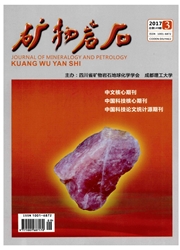

 中文摘要:
中文摘要:
本文通过对花岗岩锆石饱和温度的计算,反演了胶南晚中生代花岗岩浆的起源温度,以期对花岗岩的形成条件和构造背景做出合理的解释。胶南花岗岩的锆石饱和温度介于为815~899℃,属于高温花岗岩,高热的产生与软流圈地幔上涌有关。胶南花岗岩形成于苏鲁造山带燕山晚期岩石圈拉张减薄的构造环境,岩石圈下部发生(下地壳和岩石圈地幔)拆沉是导致拉张减薄的主因。拆沉作用也是苏鲁带壳一幔物质交换的主要机制,并引起了苏鲁造山带山脉的隆升、大规模岩浆作用、岩石圈的伸展减薄、盆地的形成和山根的消失。
 英文摘要:
英文摘要:
This paper acquired original temperatures of Jiaonan granites by calculating their zircon saturation temper- atures, which imply forming conditions and tectonic settings of the granites. The result indicated that zircon satura- tion temperatures for Jiaonan granites range from 815℃to 899℃. The Jiaonan granites are high temperature gran- ites and the high heat may relate to asthenosphere upwelling. The Jiaonan granites were formed by intensely thinning of lithosphere beneath the Sulu orogenic belt in eastern China during the Yanshanian stage. This process caused material exchanging between the crust and the mantle, and caused mountain rising and voluminous magmatic activities, which formed the Jiaolai basin and the disappearance of Yamane in the Sulu orogenic belt.
 同期刊论文项目
同期刊论文项目
 同项目期刊论文
同项目期刊论文
 期刊信息
期刊信息
